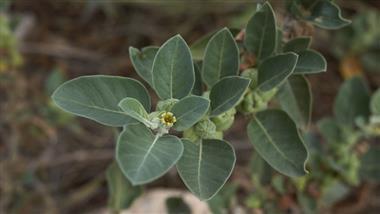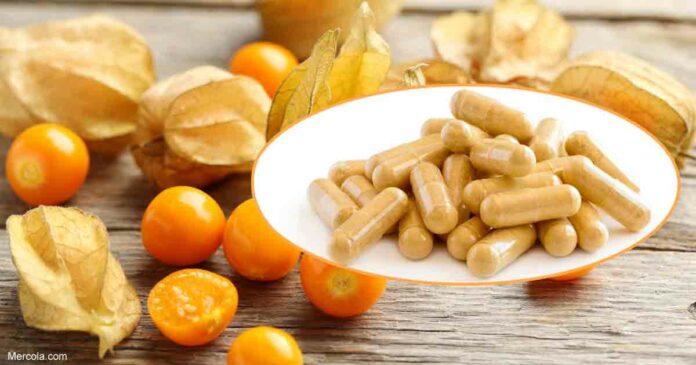Ashwagandha May Help Manage Stress and Anxiety

Story at-a-glance
- Ashwagandha, also known as winter cherry or Indian ginseng, is a popular herb in Ayurvedic medicine
- The root is the most important part of the plant, as it’s where the powder used for tonics and tinctures is extracted
- In addition to helping improve bodily function, it may impact your immune system, your ability to deal with stress and your cognitive responses
Ashwagandha (Withania somnifera), also known as winter cherry or Indian ginseng, is a popular herb in Ayurvedic medicine.1 Its name translates to “odor of horse” because of the distinct horse-like smell that its root emits. Some accounts also say that the herb was named for its ability to give you the endurance and strength of a horse.2
In Ayurvedic medicine, ashwagandha herb is classified as “Rasayana,” a type of essence that “promotes a youthful state of physical and mental health and expands happiness.”3
The ashwagandha plant belongs to the Solanaceae family, the same as tomatoes and eggplants.4 It’s a small shrub with distinct red berries and five-petal flowers.5 However, the most important part of the plant is the root, which can be extracted for use as a powder in tonics and tinctures. But what is ashwagandha good for?
In addition to helping improve bodily function, it may positively impact your immune system,6 your ability to deal with stress and your cognitive responses7 as well.
Ashwagandha’s Many Uses
As an Ayurvedic herb, ashwagandha offers numerous benefits when ingested or used as a medicine. The different parts of the ashwagandha plant have various medicinal purposes. Bitter ashwagandha leaves are used to help alleviate fever and swelling. In ancient Ayurvedic medicine, the root is crushed and made into a paste that’s used to help treat ulcers, boils, pimples and flatulent colic.8
Other ashwagandha root benefits include acting as a diuretic and as a remedy for constipation9 and insomnia.10 Ashwagandha seeds, on the other hand, are used in India to coagulate milk.11
Ashwagandha root extract, together with the berries of the plant, is used for the production of tonics and capsules, and can also be used to make tea.12 Ashwagandha may help improve your immunity,13 and has shown potential in helping with the following health concerns:
- Cardiovascular conditions19
- Parkinson’s disease20
- Arthritis21
How to Use Ashwagandha
While ashwaganda comes in many forms, ideally you should buy organic ashwagandha to avoid the possibility of ingesting pesticide residues and other harmful chemicals used in conventional farming.22
Ashwagandha root powder can be used topically as a poultice to help treat wounds, ulcers, boils and other skin infections.23,24 If you want to consume ashwagandha powder to maximize its healing uses, here is a recipe from CureJoy for ashwagandha tea with milk and cardamom.25
Ashwagandha Tea With Milk and Cardamom
Ingredients:
• 1/2 cup raw organic milk
• 1 teaspoon Ashwagandha powder
• 1 teaspoon honey
• 1/2 cup water
Procedure:
• Boil milk, ashwagandha and honey over low heat.
• Wait for it until the mixture is reduced to about 1/2 cup.
• Add cardamom and drink while it’s lukewarm. Consume this drink twice daily.
Possible Health Benefits of Ashwagandha
One of the possible benefits that ashwagandha offers for women includes improving sexual function.26 For men, possible benefits include increasing fertility and sexual drive, improving testosterone levels, helping with erectile dysfunction and helping increase low sperm count.27 Ashwagandha may also:
• Help maintain proper thyroid function — According to a double-blind, placebo-controlled study, ashwagandha effectively and significantly normalized serum thyroid stimulating hormone (TSH), T3 and T4 levels, compared to placebo, meaning it may be beneficial for people struggling with hypothyroidism.28
• Help ease insomnia — A study conducted in India, which involved 60 participants, found that ashwagandha extract improved various sleep parameters like sleep onset latency, sleep efficiency and sleep time better than a placebo.29
• Ward off infections — Ashwagandha contains steroidal lactones called withanolides, which may help combat infectious agents.30 Researchers are even studying the potential of withanone in ashwagandha to inhibit the infectivity of the novel coronavirus, although these findings are not yet conclusive.31
• Help promote longevity and slow down the signs of aging — Ashwagandha may have the potential to slow down the signs of aging by enhancing the telomerase activity. According to a 2016 study:32
“The hallmark of aging is associated with telomere; the progressive attrition of telomere in human beings contributes to mortality in several age-related diseases.
… [W]e evaluated the enhancement of the telomerase activity, which is to maintain the telomere by adding the hexanucleotide repeats, by an ancient Ayurvedic herb Ashwagandha root extract.
Indeed, Ashwagandha root extract powder, at a concentration of 10 µg – 50 µg/ml, increased telomerase activity by ~45%, in the Human HeLa cell line upon 72 hrs. exposure, as determined by the TRAP assay.”
• Help improve memory and cognitive function — In a 2017 study published in the Journal of Dietary Supplements, researchers found that ashwagandha root extract improved memory and cognitive function among people with mild cognitive impairment (MCI). Participants who took this herb found improvements in:33
◦ Short and long-term memory
◦ Executive function
◦ Sustained attention
◦ Information-processing speed
Try Ashwagandha Oil
Ashwagandha oil is another form of ashwagandha that offers a wide variety of medicinal and practical uses. It’s made from the roots through steam distillation and is usually mixed with other essential oils (or diluted in a safe carrier oil) to assist with illnesses and diseases.34
If you’re using ashwagandha oil topically, make sure to dilute it in a carrier oil such as coconut or almond oil. You should do a skin patch test to see if any allergic reactions occur, and consult your physician before ingesting it.
Do You Want to Plant Ashwagandha?
The ashwagandha plant typically grows in hot and humid climates like India, where it originates, and is quite tolerant to dry soil once the plant is established. To grow your own ashwagandha, make sure to follow these tips from Balcony Garden Web:35
• Your soil should be sandy and well-draining. It’s best to plant your seeds in a sunny part of your garden. It is nearly impossible to grow ashwagandha in a waterlogged environment that doesn’t drain.
• The plant should not be watered all the time, and should be watered only when it seems “thirsty.”
• The ideal growing temperature is between 70 and 95 degrees Fahrenheit. In colder temperatures, the plant will grow at a much slower pace. The ashwagandha plant should be fully grown in about 150 to 180 days.
Side Effects of Ashwagandha and Other Contraindications
If you’re suffering from any health problems, you should consult with your physician before taking ashwagandha orally. You should also moderate your consumption, as side effects such as diarrhea, stomach upset, nausea and vomiting could occur, particularly after ingesting high doses.36 This herb can also cause excessive drowsiness when taken with a mild sedative.37
Ingesting ashwagandha during pregnancy or while breastfeeding should also be avoided, as it could have an effect on your child.38 There are also claims that it could cause a miscarriage, so it’s better to avoid using this herb during your pregnancy.39
Like other herbs and spices, ashwagandha offers a broad variety of benefits and uses, but it should always be used in moderation. Remember, anything taken in excess — even something as beneficial as ashwagandha — may have negative effects on your body.
Sources and References
- 1, 3, 7, 8, 9, 12, 13, 22 Afr J Tradit Complement Altern Med. 2011; 8(5 Suppl): 208–213
- 2 Indian J Psychol Med. 2012 Jul-Sep; 34(3): 255–262. Introduction
- 4 Encyclopaedia Britannica, Solanaceae
- 5 Fox News, October 27, 2015
- 6 J Ethnopharmacol. 1999 Oct;67(1):27-35
- 10 Cureus. 2019 Sep 28;11(9):e5797
- 11 American Botanical Council, Issue: 99 Page: 1-7, Ashwagandha, History and Cultural Significance
- 14 J Pharm Pharmacol. 2006 Apr;58(4):513-9. Abstract
- 15 Reprod Biomed Online. 2018 Mar;36(3):311-326. Abstract
- 16 Mol Nutr Food Res. 2016 Jun; 60(6): 1342–1353. Abstract
- 17 Altern Med Rev. 2006 Dec;11(4):269-77. Abstract
- 18 Int J Mol Sci. 2009 May; 10(5): 2367–2382. 4. Conclusions
- 19 Pharmacognosy Reviews Vol 1, Issue 1, Jan- May, 2007 p 135, Cardiovascular Protection
- 20 Neurosci Lett. 2009 Apr 17;454(1):11-5 Abstract
- 21 Indian J Med Res. 2015 Jan;141(1):100-6. Abstract
- 22 Indian J Med Res. 2010 Aug;132:218-23
- 24 Journal of Pharmeceutical Biology. 2010 Sept; 48:12, 1397-1404
- 25 CureJoy.com, November 21, 2017
- 26 Biomed Res Int. 2015;2015:284154
- 27 Phytomedicine. 2018 Nov 15;50:247-256
- 28 The Journal of Alternative and Complementary Medicine. August 22, 2017
- 29 Cureus. 2019 Sep 28;11(9):e5797
- 30 Journal of Biological Sciences, 2014, 14: 77-94. Abstract
- 31 Virology, March 20, 2020
- 32 Advances in Bioscience and Biotechnology Vol.7 No.4, April 2016
- 33 Journal of Dietary Supplements February 21, 2017
- 34 Innovative Private Label, October 16, 2017
- 35 Balcony Garden Web, 2015, How to Grow Ashwagandha, Cultivation and Growing Ashwagandha
- 36 LiverTox: Clinical and Research Information on Drug-Induced Liver Injury, Ashwagandha, 2019
- 37, 38 Rx List, Ashwagandha, Are There Safety Concerns?
- 39 MedlinePlus, Ashwagandha

